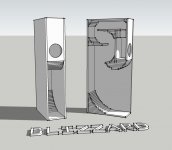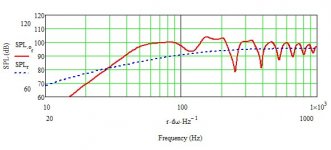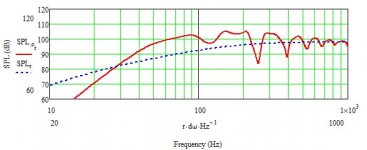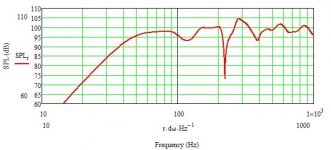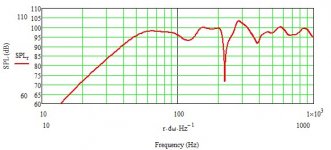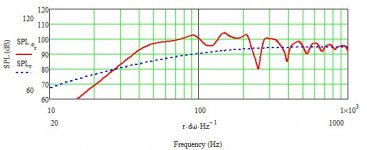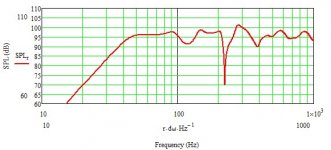You know, I was going through my designs and with the 8" full range driver being so common these days I thought I would mention a design I did last winter that should work equally well for the AN, Lowther, Tang Band, Dayton etc. etc. Low Qts drivers. The reason I never finished it and put it up for whoever wants it is my roof broke under the weight of the snow we had here in the District of Columbia. I was so busy dealing with that that I forgot about this design. Not only that but the last year has been a busy one with my house and with the 2 way 3 way and line array projects I have been working on. That said here's the pitch:
The Blizzard
More compact than any long path 8" BLH that I have designed as of yet. It should have an F3 of around 40 Hz and an F6 of around 36Hz. The design overall looks pretty promising. Have a look at the projected in room simulation. Dimension are around 11x25x56 inches. The build should be easy as there are zero mitered joints in this one (I know amazing coming from me!)
I haven't done a cut sheet, or a plan packet yet but that can be arranged if there is any interest. FWIW I figured I would ask after this since I always love to get plans for my ideas out there.
Plot1 shows the projected in room response simulation and plot2 shows the simmed combined system response. Overall pretty nice looking.
Tom
The Blizzard
More compact than any long path 8" BLH that I have designed as of yet. It should have an F3 of around 40 Hz and an F6 of around 36Hz. The design overall looks pretty promising. Have a look at the projected in room simulation. Dimension are around 11x25x56 inches. The build should be easy as there are zero mitered joints in this one (I know amazing coming from me!)
I haven't done a cut sheet, or a plan packet yet but that can be arranged if there is any interest. FWIW I figured I would ask after this since I always love to get plans for my ideas out there.
Plot1 shows the projected in room response simulation and plot2 shows the simmed combined system response. Overall pretty nice looking.
Tom
Attachments
Sorry Dave, the driver in the sim is the Tang Band W8-1772. I am about to sim it with the new Dayton and see what that turns back.
Tom
Tom
Okay, here are the projected system graph and the projected in room system graph respectively for the Dayton PS220-8. Looks promising! Almost looks like the extension will be a little lower than the Tang Band but I don't know how either sounds as I haven't been able to audition either.
Tom
Tom
Attachments
Tang Band W8-1772
That driver, when introduced, was a bit costy given the performance, with a near doubling of price, its cost/performance is now way out of touch.
The Dayton has only gone up $10 each, so is still in the running.
dave
Yeah, I remember that being an expensive unit. I had no idea that they were at 321 a piece now. There is no way I would support Tang Band at this point. All of their prices have gone through the roof. Good news is I designed the horn to work with pretty much any of the 8" low Q drivers out there. I am very interested in this Dayton of course. The list of drivers that I feel are competitive that can be dropped in to this horn are of course the ANS8, Cast ANS8, Dayton PS220-8, Decware DFR-8, and on another level the Sonodyne' Lowther, etc. As long as it's 8 inches with a qts of say between .15-.3 they should be a good match. Does this sound like a reasonable range Dave?
As an afterthought, I forgot to mention all the low Qts Fostex drivers. Sorry guys, I just don't do their stuff anymore. I lost the "taste" for their sound. All apologies!
Tom
As an afterthought, I forgot to mention all the low Qts Fostex drivers. Sorry guys, I just don't do their stuff anymore. I lost the "taste" for their sound. All apologies!
Tom
Last edited:
Sorry to keep posting guys but I realized that I had posted a sim based on the published T/S parameters for the Dayton and not the measured. Following are the measured sims. First is the combined sim of projected FR and the second is the combined sim of in room projected FR. Once again, sorry guys.
Tom
I hate switching system as well. I am a Mac user that keeps PCs around for just this sort of stuff. Why won't the Mathcad folks support Mac? Ah well...
Tom
I hate switching system as well. I am a Mac user that keeps PCs around for just this sort of stuff. Why won't the Mathcad folks support Mac? Ah well...
Attachments
... Decware DFR-8...I forgot to mention all the low Qts Fostex drivers. Sorry guys, I just don't do their stuff anymore. I lost the "taste" for their sound.
The Decware retains most of the character of the FE206 it is based on.
dave
That looks like a really cool design, and one that could be built without a lot of tools. I’ve always wanted to try the Fostex FW208N in a blh. The specs look great to me.
fs 29 Hz
Qms 13.2
Qes 0.21
Qts 0.20
Mms 40 g
Cms - mm/N
Sd - cm2
BL - N/A
Vas 43.4 ltrs
Xmax 6.5 mm peak
Is there any way you could sim it? Thank you.
fs 29 Hz
Qms 13.2
Qes 0.21
Qts 0.20
Mms 40 g
Cms - mm/N
Sd - cm2
BL - N/A
Vas 43.4 ltrs
Xmax 6.5 mm peak
Is there any way you could sim it? Thank you.
This is definitely a very promising and doable design.
One modification you may want to investigate is to put a kind of wedge behind the driver so that less of the sound hitting the back of the compression chamber is reflected back through the driver cone. For example, a lot of Lowther cabinets have angled panels behind the driver opening, I think (perhaps a wrong assumption?) that this is the reason.
About:
Well, I haven't heard it yet, but in the two German loudspeaker DIY magazines it was well received. As in: not cheap, but very good performance as well.
One modification you may want to investigate is to put a kind of wedge behind the driver so that less of the sound hitting the back of the compression chamber is reflected back through the driver cone. For example, a lot of Lowther cabinets have angled panels behind the driver opening, I think (perhaps a wrong assumption?) that this is the reason.
About:
That driver, when introduced, was a bit costy given the performance, with a near doubling of price, its cost/performance is now way out of touch.
Well, I haven't heard it yet, but in the two German loudspeaker DIY magazines it was well received. As in: not cheap, but very good performance as well.
Last edited:
As an afterthought, I forgot to mention all the low Qts Fostex drivers. Sorry guys, I just don't do their stuff anymore. I lost the "taste" for their sound. All apologies!
Tom
you might want to give a listen to the new WK series - even bone stock the little FF85WK is very nice - and maybe acceptable to the palates of those who find the FE series wearying.
I know the qts is a bit higher than the ideal range but what about the Fostex F200A ?
I've got a pair in a JE Labs OB currently and am looking for a suitable design with a higher WAF.
Thanks, Daniel.
I've got a pair in a JE Labs OB currently and am looking for a suitable design with a higher WAF.
Thanks, Daniel.
I know absolutely nothing about these types of designs but it looks doable for me to try and at a price point that wouldn't scare the wife. I will definately be watching this thread for updates. I for one am completely interested in trying this out.
The Decware retains most of the character of the FE206 it is based on.
dave
Gotcha Dave. I have been out of the loop as of recently. I have a lot of threads and industry stuff to catch up on. Thanks for the heads up! 🙂
Tom
That looks like a really cool design, and one that could be built without a lot of tools. I’ve always wanted to try the Fostex FW208N in a blh. The specs look great to me.
fs 29 Hz
Qms 13.2
Qes 0.21
Qts 0.20
Mms 40 g
Cms - mm/N
Sd - cm2
BL - N/A
Vas 43.4 ltrs
Xmax 6.5 mm peak
Is there any way you could sim it? Thank you.
I'll try to get that summed this afternoon. I know it will look very similar. My experience with that driver is the bass shoulder is less sharp but more gradual. I will get it summed and try to get it up today.
Tom
This is definitely a very promising and doable design.
One modification you may want to investigate is to put a kind of wedge behind the driver so that less of the sound hitting the back of the compression chamber is reflected back through the driver cone. For example, a lot of Lowther cabinets have angled panels behind the driver opening, I think (perhaps a wrong assumption?) that this is the reason.
About:
Well, I haven't heard it yet, but in the two German loudspeaker DIY magazines it was well received. As in: not cheap, but very good performance as well.
You are correct about that assumption but I have found that its easy enough to put some dense wool or acrylic batting on the back wall, the bottom, top and the sidewalls. That very effectively eliminates standing waves. There are plenty of other techniques like angled back walls which you will see in my other designs or even CNC routed dense tooth angled patterning that effectively breaks up the wave. In my experience I have found the side walls to be more of a problem than the back wall because the space is so small the radiation of the wave pattern bounces all over the place causing odd effects such as echoing and breakup. The reason for no angled rear wall in this design however is that that would make for a design that is far harder to build. I designed this speaker to be easy to build. The only tools truly required are a circular saw with a homemade guide that gives repeatable results. I wouldn't build it that way but if thats all you have, it's quite possible. That said, this design was really created with the use of a table saw or guided plunge saw to cut your 4x8 or 5x5 sheets of ply or mdf to width and a mitre saw to cut all the inside panels to size. Inside width is 9.5 inches. Any good mitre saw or sliding mitre saw will be capable of cutting this width and everything is designed to be 90 degree cuts. The nice side effect of this is a relatively narrow baffle width which helps with baffle step concerns. Another concern with my past designs comes because I am a decent woodworker so I am known for designing loudspeakers with all sorts of crazy inside angles that required special jigs to cut which I endeavored to avoid on this design. In other words, only a few hours of saw use are required and the devil will be in the details of construction which should also be fairly painless but somewhat time consuming. These cabinets are also designed to be inherently heavy. No need for ballast to weight the cabinet. This should make for tighter lows. Bracing in the horn mouth may or may not be necessary depending on materials used and whether you use another layer of wood on the outside or some sort of external bracing (which could look very cool) on the cabinet. I haven't found that the mouth of the horn flexing causes much loosening of the bass on my designs but many people claim they hear a difference so that decision is up to the builder.
All this said, I think there is enough interest in the design that I will finish up the drawings and start on some cut sheets for both 4x8 and 5x5 sheets of 3/4 inch ply and MDF.
I am finding that work takes my time and I am really more interested in others building and testing and improving my designs along with me than I am in taking anything in to the commercial realm these days. I love the process that has resulted from these types of public collaborations such as what Dave and Scott have done. These two folks have been of great help on the path to my designs as have GM and Chris so thanks go out to all of those guys.
Okay, enough rambling. I will try to get the plans out for people to start checking for errors here in the next few weeks. I really am trying to get my new line array built too so many things are on the plate over the next month before I have to get back to teaching.
Tom
Last edited:
I know the qts is a bit higher than the ideal range but what about the Fostex F200A ?
I've got a pair in a JE Labs OB currently and am looking for a suitable design with a higher WAF.
Thanks, Daniel.
It would be possible but not ideal. The lows would be boomy and the extension of that cone could be a problem. Worth a shot! I could sim it but the FR sim wouldn't tell the whole story. The impedance curve might be more revealing but I could be wrong. GM usually has some solid things to say about this very subject if he is listening, input might be a good thing! 🙂 That driver is just not really designed for a expanding line chambered TL or a "back loaded horn" as we all love to call it.
Dave, Scott, GM any thoughts?
Tom
One other though. I have tried non horn suitable drivers in some of my horn cabinets and sometimes it worked while others it just became a situation where I could damp the line enough to make it usable. Fact is, with the low price of these drivers, building this design and trying out your drivers is a fairly doable proposition. If it doesn't work, you buy a set of something you know will. That simple. Of course 200-400 bux is a decent chunk of change but nothing like buying 4000 dollars worth of morel drivers and building loudspeaker cabinets that will just never work for them (I know someone who did this and then didn't have the know how to design a cabinet that would work. Not smart). I hope this helps!
Last edited:
That looks like a really cool design, and one that could be built without a lot of tools. I’ve always wanted to try the Fostex FW208N in a blh. The specs look great to me.
fs 29 Hz
Qms 13.2
Qes 0.21
Qts 0.20
Mms 40 g
Cms - mm/N
Sd - cm2
BL - N/A
Vas 43.4 ltrs
Xmax 6.5 mm peak
Is there any way you could sim it? Thank you.
It doesn't look like this driver will be a good match at all. That was a good thought though!
Tom
Attachments
you might want to give a listen to the new WK series - even bone stock the little FF85WK is very nice - and maybe acceptable to the palates of those who find the FE series wearying.
Chris. I simmed the FF225wk in this enclosure and it actually looks really nice. I wonder how it compares to the dayton? Have you had a chance to compare them? Attached are the sims. The first is system FR and second is system in room FR.
Tom
Attachments
- Status
- Not open for further replies.
- Home
- Loudspeakers
- Full Range
- New BLH for 8" drivers "The Blizzard"
